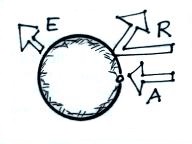
What would the relationship be between Absorption,
Emission, and Reflection when this planet is in
radiative equilibrium?
mixing ratio (r) - the actual amount of
water vapor in air expressed as grams of water vapor per
kilogram of dry air (think about what the units mean). This
variable is not affected by changes in air temperature (unless
you cool air below its dew point temperature) or pressure, it
changes only when water vapor is added to or removed from the
air.
saturation mixing ratio (rs) - the water
vapor capacity of the air in grams of water vapor per kilogram
of air. This property of air depends on temperature; you can
look the value of rs
in a chart or on a graph.
Saturation is an upper limit to the
amount of water vapor that can be found in the air. The
saturation mixing ratio is a property of air and depends on
the air temperature - there can be a lot more water vapor in
warm air than in cold air. When air is saturated with water
vapor, RH = 100% and condensation balances evaporation.
relative
humidity (RH) - the amount of water vapor expressed
as a percentage of the maximum amount (the saturation amount):
RH = 100% x r /rs

